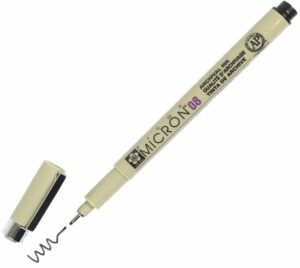Archive:
Ketubah Tradition
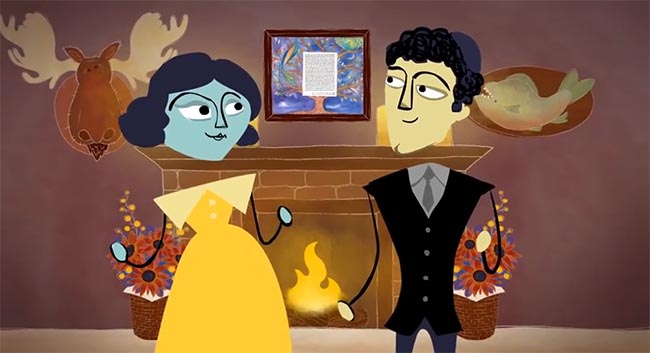
Before I had my own Jewish wedding, I was rather mystified by the vast majority of Jewish wedding customs. Each custom came with its own name, its own props, its own ceremony, and sometimes even its own music. And there were a lot of them!
Plus, since these customs each looks slightly different depending on your denomination and your specific Rabbi, my internet research was leaving me more confused than enlightened.
That is, until I stumbled upon Meaningful Jewish Screentime
This Youtube channel is incredible. Oh. My. Goodness. It tackles every major lifecycle and holiday event in the Jewish tradition and explains their significance in short, animated clips. Not only is the animation and artwork completely adorable, but they manage to make complicated customs understandable, and therefore more meaningful.
They’ve even created a segment on the ketubah!
I definitely encourage you to pop over to their channel and check out the wedding section. This stuff is pure gold!
Read More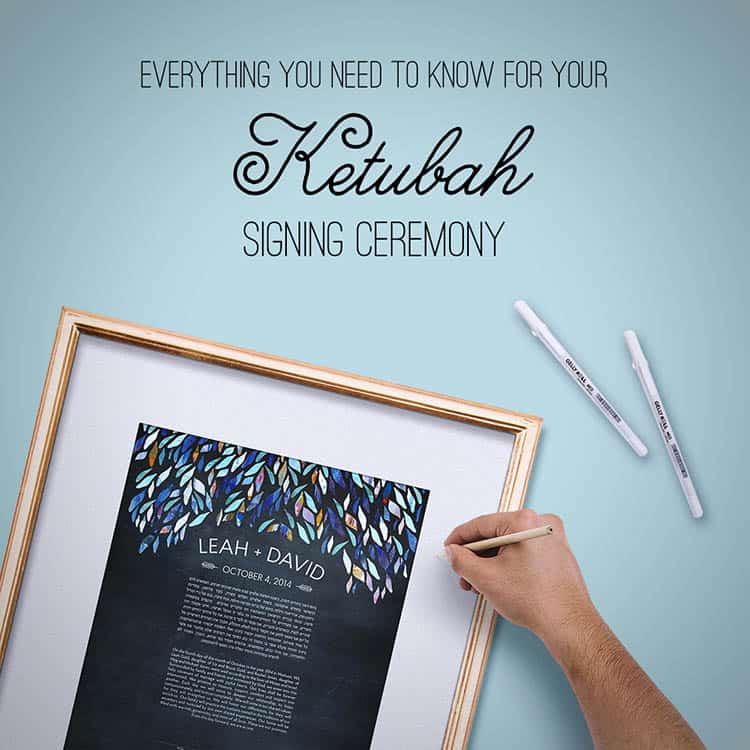
So, you’ve found your ketubah artist, placed your order, chosen your text, and the beautiful document has arrived at your doorstep. Time to cross “ketubah” off your wedding to do list? Not quite.
While purchasing and customizing your ketubah is definitely the most time consuming part of the process, there’s still one thing left to coordinate – the ketubah signing ceremony. If you’re working with a wedding coordinator who’s familiar with Jewish weddings (lucky you!) he or she will probably handle a lot of these logistics for you. But if not, it’s important to run through this checklist before the big day so that you don’t find yourself rushing to sign your ketubah in a dark hallway with a smudgy pen 2 minutes before the ceremony.
Here’s a list of what needs to get done before your wedding day arrives:
1. Plan ahead for how your ketubah will get to and from the ceremony.
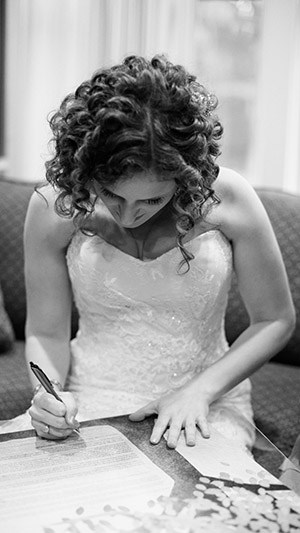
You’ll be coordinating the movement of lots of little things (hello table numbers, bouquets, and favors!) in the days leading up to your wedding, so make sure that the ketubah makes that list. You should leave it protected in a tube or frame during transfer so that it doesn’t get damaged. Make sure that someone you trust is in charge of getting it to the venue and seeing it safely home after the reception. As someone who was recently married herself, I highly recommend that you give this job to someone else and not try to handle it yourself. You’ll be way too wrapped up in the day itself to think about lugging around your ketubah.
2. Have the right pen.
While most pens will work just fine for signing your paper ketubah, I do have a couple of suggestions. Personally, I recommend that you use a uni-ball GEL pen, as these are least likely to scratch the surface of your fine art paper ketubah. These pens are available in a wide variety of colors, and the metallic and white colors work wonderfully on the ketubahs with dark backgrounds. Make sure to have an extra piece of paper with you for the signing ceremony, so that each person can practice their signature before signing on the real thing! And again, make a plan for how those pens are going to get to the ceremony.
3. Find the right space.
Ideally, your venue will have a quiet room with a table that can comfortably fit the Rabbi, the couple, the witnesses, and any other honored guests you’ve asked to attend the signing. Check with your venue ahead of time about what space would best fit your needs, and have your ketubah and pens set up there so they’re ready to go!
4. Know who your witnesses will be.
It’s easy to remember to select your witnesses ahead of time. After all, it’s a lot of fun to ask someone to fill an honored role in your wedding ceremony. (Psst, here are my tips on how to pick your witnesses.) But the step people often forget is to make sure that their ketubah witnesses know when and where to meet for the signing ceremony. The last thing you want to do is make the groom run around the venue 5 minutes before your wedding is supposed to start trying to track down your errant witness. Make sure the witnesses have all the information they need, and the signing ceremony will go smoothly!
5. Have a plan for displaying your ketubah.
Many couples choose to display their signed ketubah during the wedding ceremony and reception. If that’s your plan, be sure to have an easel ready to go and an inexpensive frame on hand to protect your ketubah from spilled wine, weepy guests, and small grubby hands 🙂 I specifically recommend a cheap frame because I’ve heard one too many stories about people bumping into the ketubah during the ceremony and knocking it to the floor. The cheap frame will protect your ketubah in the case of disaster, but will probably be broken itself if it’s knocked to the floor. So you don’t want to invest in an expensive professional frame until that ketubah is ready to live safely on your wall at home.
A quick note about the ketubah signing ceremony itself
Now that all the logistics are locked down, here’s a brief rundown of how the actual signing ceremony usually goes. Of course, the specifics will always depend on your Rabbi, the type of ceremony you’re having (Orthodox, Secular, Interfaith, etc.) and the preferences of the bride and groom. But typically, the group will assemble in the predetermined space 20-30 minutes before the wedding ceremony is set to begin. The Rabbi will perhaps briefly explain to the assembled the significance of the ketubah. Then he or she will read the document in full. Often, the Rabbi will ask the two witnesses to sign the document first, since historically theirs were the only signatures that mattered in the legal sense. After each person has signed, the ketubah will be placed back in its frame, and returned to its easel in the wedding ceremony or reception space.
That’s it!
If you do just a few things to prepare for your ketubah signing ceremony, it’s destined to go smoothly. And if you have any questions, be sure to ask your Rabbi how they typically handle this part of a Jewish wedding!
Read MoreThis post is part of my “ketubah tradition” series, where I dig into the details of your ketubah signing ceremony.
So, your ketubah or wedding certificate has been purchased, designed, approved by your Rabbi, printed, and shipped to your door. Congrats! But before you officially cross it off your ever-growing wedding to do list, there’s one last thing to think about. Selecting a ketubah pen!
Contrary to what you might expect, the cheaper the pen, the better it tends to work in this situation. The ink from fancy fountain pens is far more likely to splatter and smudge. Plus, if you’re using nervous / shaky hands (and who isn’t right before their wedding ceremony!) the sharp nibs can even scratch the surface of your fine art paper ketubah or wedding certificate.
Ultra fine felt-tip pens can also scratch the surface if you press too hard, and sharpies can bleed on the soft cotton rag paper your ketubah or wedding certificate is printed on.
So, what’s a bride or groom to do?
PRO TIP! Bring a fancy fountain pen with you to your wedding for the photos. You can pose holding the fancy pen. But when it actually comes time to sign, try one of the options below.
The perfect ketubah pen
There are two brands of pens I recommend for signing your ketubah or wedding certificate.
PAPER KETUBAHS AND WEDDING CERTIFICATES
If you’ve ordered a fine art paper ketubah or wedding certificate, a simple wide felt-tip pen is probably your best bet. (Though in a pinch, any normal ball-point usually works just fine.) We like the Sakura Pigma Micron in the 08 size, which is bigger than the standard 05/03/01 that you typically find. If you ordered a paper cut or 3-D ketubah, one of these pens will be included in your package.
KETUBAHS AND WEDDING CERTIFICATES WITH DARK BACKGROUNDS
What if the design you selected has a dark background? We like the Uni-Ball Signo pen series. The ink flows a bit more freely in this pen, so be careful to let it dry before touching your signature. But you’ll find that it writes smoothly even on the textured canvas. And it has all the other benefits you’re looking for – including chemically-stable, waterproof, fade-resistant inks and a variety of color options. I would recommend white, silver or gold on the ketubahs and wedding certificates with dark backgrounds. White will have the most contrast, but the silver and gold are also very pretty.
Uni-ball Signo White – 3 pack
Uni-ball Signo Gold – 3 pack
Uni-ball Signo Silver – 3 pack

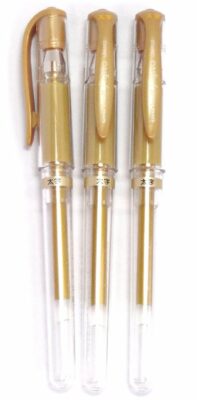
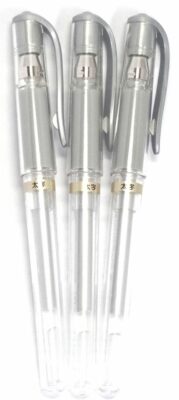
STRETCHED CANVAS KETUBAHS AND WEDDING CERTIFICATES
If you’ve ordered a ketubah or wedding certificate on stretched canvas, a black, fine tip sharpie works best for the light color backgrounds. This is the least likely to smudge on the canvas. If it’s a canvas with a dark background, I still recommend the Signo pen series above. Just be sure to give the signatures plenty of time to dry before touching them. Ink dries a bit more slowly on the canvas than it does on the fine art paper.
One last tip. It never hurts to have an extra piece of paper on hand so that each person can practice their signature once on scrap before putting pen to paper on the real thing.
Happy signing!
FYI: As of October 2017, this post now contains affiliate links! I’ve been recommending these exact products for years without being an affiliate, and I stand by my recommendations now. As such, Amazon requires me to include the following: “I am a participant in the Amazon Services LLC Associates Program, an affiliate advertising program designed to provide a means for me to earn fees by linking to Amazon.com and affiliated sites.”
Read MoreI recently met a woman named Elise who is in the process of planning a secular Jewish wedding. I was fascinated to hear about her plans and how she and her fiancé are walking a fine line between celebrating their Jewish heritage and also crafting a ceremony that reflects their spiritual beliefs. She was kind enough to stop by my blog to tell us a little bit about the process!
You and your fiancé were both raised in Jewish households, and very much see yourself as Jewish, but you also both identify as secular, and don’t plan on having a lot of religious components to your wedding. Tell me a little bit about how you put together your wedding ceremony and what that will look like.
Sure! My fiancé and I met in college. After college, as things started to get serious, we were happy to discover how aligned our cultural and spiritual beliefs are. Growing up, both of our families attended a Reform synagogue (mine regularly, his mostly just for the holidays), and being Jewish was a huge part of both of our identities. But as I got older, I began to question the spiritual aspects more and more. I’m still very much questioning, but I’m finding myself increasingly drawn to Secular Humanism. My fiancé feels the same way, but spends less time than I do thinking about it!
When we got engaged and began to plan our wedding, we both very much wanted to include the ceremonies that were important to our families and that we had seen in other weddings in our Jewish communities. But we wanted to find a way to incorporate them without the religious overtones that didn’t feel authentic to us. It was a challenge at first! But then we found a great Secular Humanistic Rabbi to officiate who helped us through some of those decisions.
In the end, we’re choosing to be married under the traditional Huppah by a Rabbi, have a Secular Humanisitc version of the seven Jewish wedding blessings recited, and my fiancé will smash the glass at the end. We’ve also decided to sign a secular ketubah before the wedding, as is traditional.
As you may have guessed, I’m pretty interested in the tradition of the ketubah, and how it can be a part of a wide range of weddings. Why did you choose to include a secular ketubah signing in your ceremony? Was it difficult finding a secular ketubah?
We decided to include a ketubah signing for a couple of reasons. The first is that we both love the fact that this tradition has been a part of the Jewish wedding for literally thousands of years. But we also felt as though it would have a lot of personal significance to us. We love the idea of having a document that captures our wedding promises hanging in our home. And since we’re looking for a secular ketubah, we have a lot more flexibility in picking or writing a text that speaks to us personally. We’re probably going to select some version of the Secular Humanistic ketubah text, but we’ve been talking about writing our own as well.
Thanks so much Elise for stopping by my blog this week! Are you interested in having a Secular Jewish wedding ceremony or finding a Secular ketubah?
Here are a few secular ketubah resources for you:
Association of Humanistic Rabbis
Seven Jewish Wedding Blessings – A Secular Humanistic Version
Secular and Secular Humanistic Ketubah texts
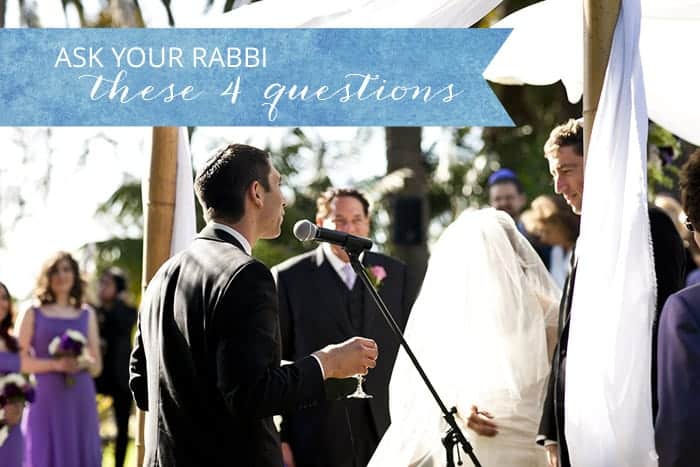
Congratulations! You’ve gotten engaged to the love of your life, wedding plans are underway, and it’s time to start hunting for that perfect ketubah. But before you go too far down the rabbit hole of artists, designs, and text options, you might want to pick up the phone and give your Rabbi or Officiant a call. The ketubah is a critically important part of the Jewish wedding ceremony. Depending on the type of ceremony you’re having and the denomination of your Rabbi, there may be some requirements in place for your ketubah of which you may not be aware. It definitely pays to have a quick chat with your Officiant before you fall in love with a particular design. So, before your hunt begins in earnest, ask your Rabbi these four questions:
1. What are your requirements for our ketubah text?
Each Rabbi will have different requirements when it comes to selecting your ketubah text. An Orthodox Rabbi will typically require you to use the original Aramaic Orthodox ketubah text. A Conservative Rabbi will typically ask that you use the original Aramaic ketubah text with the addition of the Lieberman Clause. Other Rabbis may have additional requirements still. Most (but not all) established ketubah artists are experienced at accommodating any Rabbi’s requirements into their texts. But it pays to know ahead of time what you’re looking for. It will help you to get a more accurate quote from your ketubah artist, and will save you the trouble if a particular artist can’t offer the specific text you need.
2. How should we handle everyone’s names in our ketubah?
There are several ways to handle everyone’s names in a ketubah, so it helps to know your Rabbi’s stance before you finalize your text. Some Rabbis leave it up to you whether or not to include your parents’ names in your text, and others see it as a requirement. The trickiest situations are those where you’re getting an Orthodox or Conservative ketubah text, but you’re having an interfaith marriage, or one partner has converted to Judaism. In these instances, the converted partner’s parents are often listed as Abraham and Sarah in the Hebrew text, while their names are left unchanged in the English text. It get’s confusing, see? That’s why it helps to have a clear idea from your Rabbi how they would like this handled.
3. What should we put for the date of the ceremony?
You’d think that the date of your wedding should be pretty straight-forward, but unfortunately, that’s not always the case. That’s because, in the Hebrew calendar, the date changes at sunset and not at 12:00 am. It’s further complicated by the fact that, in Jewish law, you technically shouldn’t marry on Shabbat (or after sunset on Friday / before sunset on Saturday). So if you’re wedding ceremony happens just before sunset on Saturday, your Rabbi may ask that your ketubah list the Hebrew date as being after sunset. This is easy for the ketubah artist to do, but they just have to know ahead of time!
4. Who can sign our ketubah?
Again, depending on the type of ceremony and the type of Officiant you’ll have at your wedding, there may be strict or very loose requirements for selecting your ketubah witnesses. You can read a lot more about those requirements and my personal philosophy for selecting witnesses over here. But just a reminder that it’s a good idea to ask your Rabbi what their requirements are for who can sign and/or how many people can sign as witnesses. I’ve done ketubahs for couples who wanted to include up to 8 witnesses in the signing ceremony – and this was perfectly fine with their Rabbi. But it’s definitely a good idea to know where your Rabbi stands on the issue before asking your nearest and dearest to be witnesses for you.
Each Rabbi and Officiant will have a different set of requirements for your ketubah, so it pays to know ahead of time. A good ketubah artist will be able to accommodate anything your Rabbi asks of you, so don’t be shy about sharing your Rabbi’s requirements with artists you’d like to work with. That’s what we do!
Photo Credit: Carlberry
Read More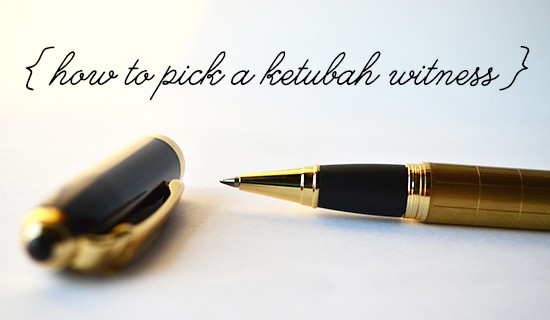
So, you’ve found a ketubah artist, picked out your ketubah text, and had your document personalized to fit your and your Rabbi’s vision. Good work! Time to cross that off your wedding to do list? Not quite. You still need to pick your ketubah witnesses.
Let me tell you a little bit about the various Jewish perspectives on this decision, and then I’ll tell you how we chose our witnesses (spoiler alert – we did things a little differently).
First, a tiny bit of ketubah history
According to Orthodox Jewish law, a wedding ketubah is considered a binding contract as soon as it has been signed by the two witnesses. That means that the signatures of the bride, groom, and Officiant aren’t even required and only began showing up in ketubahs in modern times!
Different Jewish branches have diverging perspectives on who can be a ketubah witness.
Orthodox / Conservative: In Orthodox and Conservative communities, the two witnesses must be adult, male, observant Jews who are unrelated to the bride and groom.
Reform / Reconstructionist: In more liberal Jewish communities, the rules are often more relaxed and depend on the wishes of the specific Rabbi. Many Rabbis are fine with female and non-Jewish wedding guests as ketubah witnesses. Other Rabbis will fall somewhere in between the two perspectives.
Interfaith / Secular: When you’re having an Interfaith or Secular ceremony, all bets are off. Talk to your Officiant to make sure he or she doesn’t have any specific requirements, but other than that, you can ask whomever you please.
IMPORTANT NOTE: Whatever kind of wedding you’ll have, the most important thing is to talk to your Rabbi or Officiant ahead of time to make sure you understand any requirements that he or she has. You definitely don’t want any surprises during the ketubah signing ceremony!
But how do I actually pick my ketubah witness?
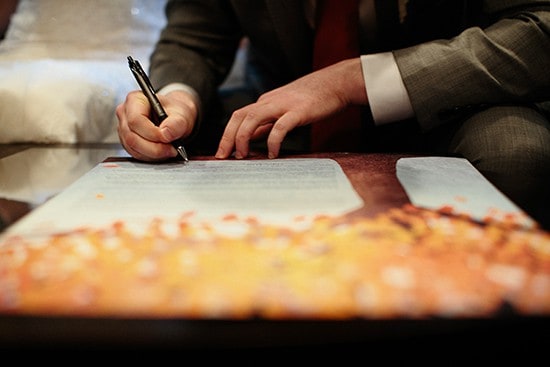
It will come as no surprise that signing someone’s wedding ketubah is an enormous honor. After all, you’re asking that person to seal your marriage with their signature, and to support your union in good times and bad.
When my husband and I sat down to talk about who would sign our interfaith ketubah, we agreed that we didn’t just want to ask close friends. After all, there are many ways to honor those you love at your wedding, but signing a ketubah is a special responsibility. So instead, we each spent some time thinking about which friends of ours had the type of marriage that we wanted to emulate in our own relationship.
I ended up asking my friend Carol. While her husband had passed several years before, I always saw their marriage as a beautiful, egalitarian partnership and as a source of strength and joy for both of them.
My husband asked his friend Mark, whose marriage was constantly filled with adventure, laughter and resilience, no matter what challenges came their way.
Now every time we look at our ketubah, we not only see the words we spend so long crafting together, but also the signatures of two dear friends whose marriages are a constant source of insight.
It may feel as though picking your ketubah witness is an easy task to cross of your list. But I encourage you to really give it some thought, and to pick people who will keep you inspired for many years to come.
Read More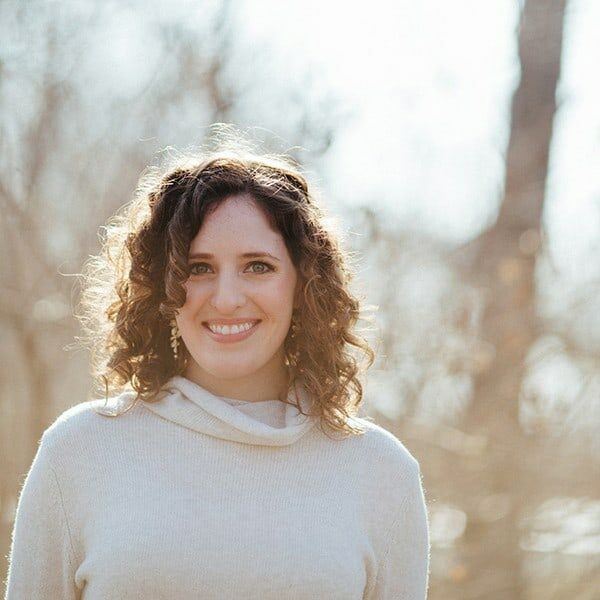
Hello!
I'm Adriana Saipe, founder of Ink with Intent. I'm a full-time wedding illustrator who specializes in contemporary ketubahs and unique wedding certificates. Learn more.

Be the first to get special offers, updates from the studio, and more
CONNECT:

